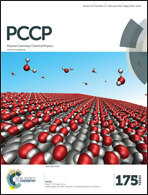Assembly of polyaniline nanotubes by interfacial polymerization for corrosion protection†
Abstract
Polyaniline (PANI) was synthesized by the oxidation of aniline with ammonium peroxydisulfate as an oxidant in an immiscible organic/aqueous biphasic system and with decylphosphonic acid (DPA) or benzylphosphonic acid (BPA) in the aqueous phase. Nanofibers of aniline oligomers were produced using BPA in the aqueous phase while high quality polyaniline nanotubes were produced using DPA in the aqueous phase. PANI nanotubes have a outer diameter 160–240 nm, an inner diameter of 50–100 nm and a length of the order of several μm. The understanding of the formation of PANI nanotubes was examined by isolation of reaction intermediates and their ex situ characterization by atomic force microscopy. The roles of BPA and DPA on the morphology formation of the PANI nanostructures were discussed. A nanofibrillar template produced by aniline oligomers was found to guide the growth of PANI to nanotubular morphology. PANI nanotubes are thus not derived from DPA vesicles. Preliminary corrosion tests exhibit high corrosion protection efficiency of PANI nanotubes because of their high surface area and corrosion inhibitive properties of DPA dopant.


 Please wait while we load your content...
Please wait while we load your content...